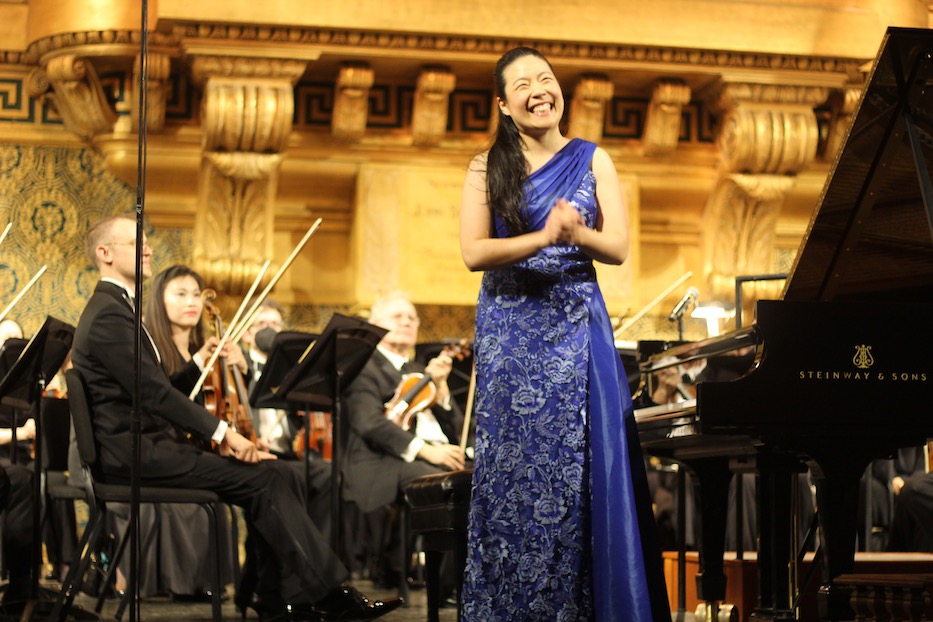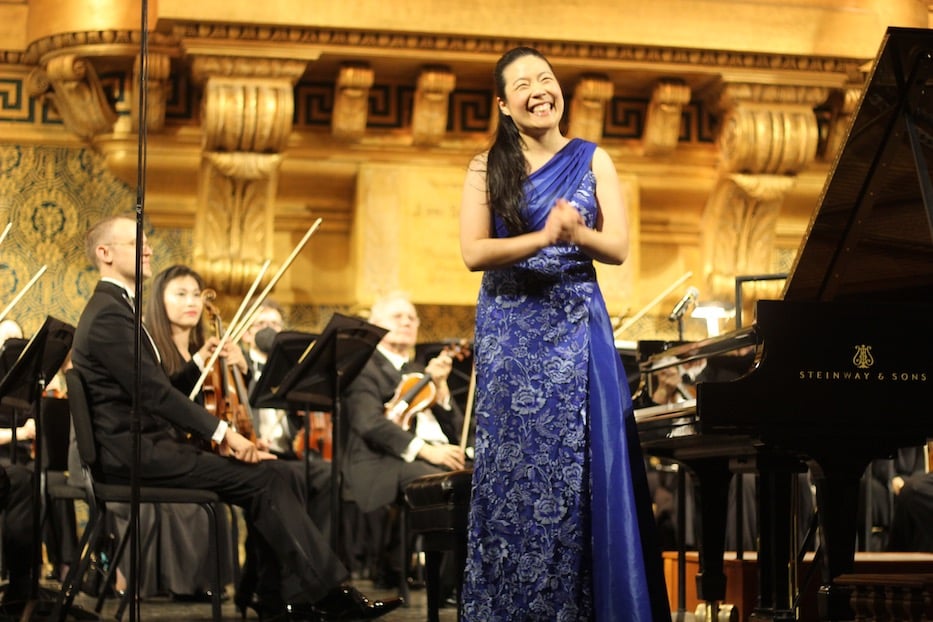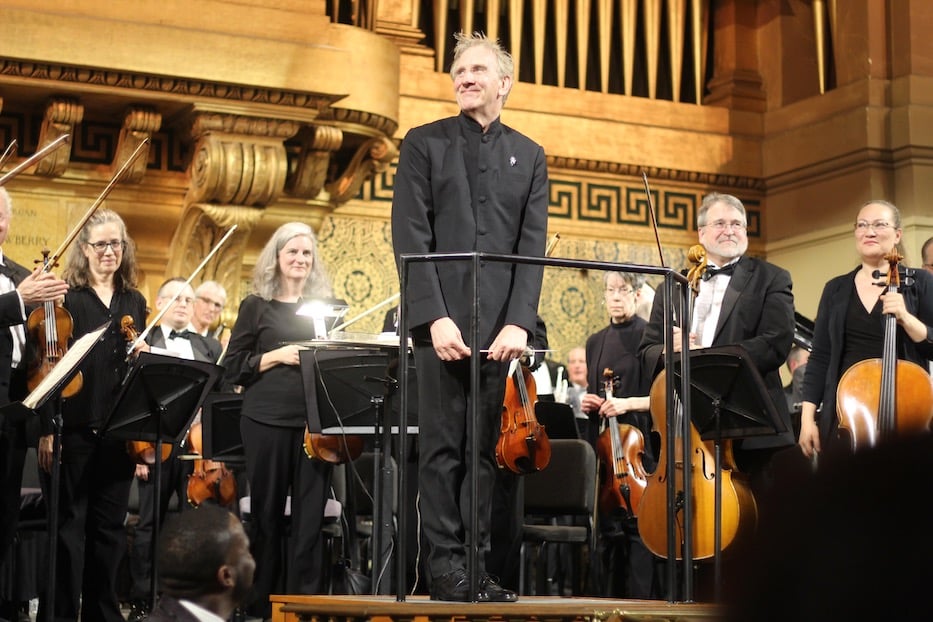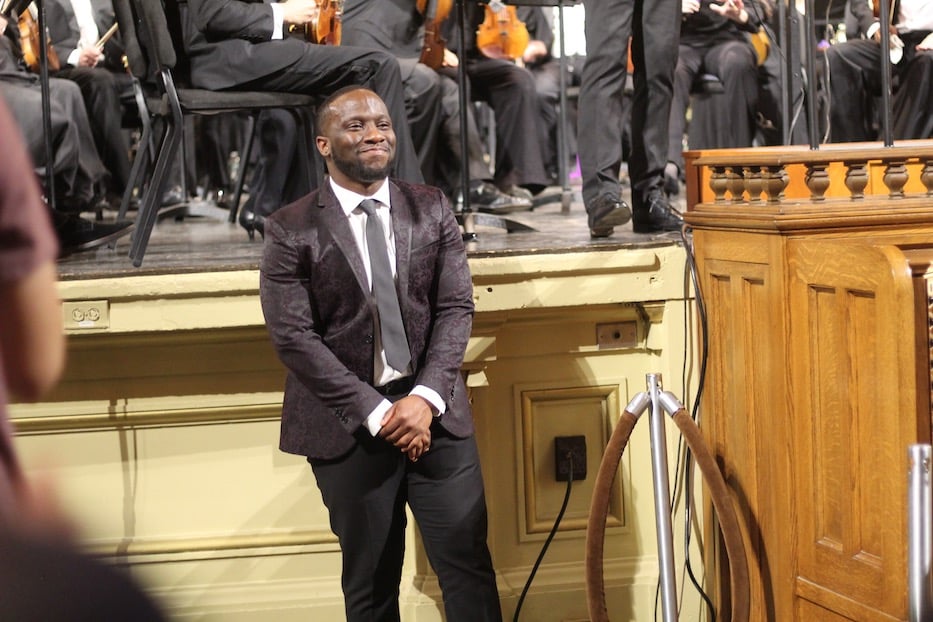
Culture & Community | Downtown | Music | Arts & Culture | New Haven Symphony Orchestra

Joyce Yang Thursday night. Lucy Gellman Photos.
Woolsey Hall was all but vibrating. At the center of the stage, pianist Joyce Yang swayed over the keys, her fingers flying as musicians waited to come back in. Strings entered, and the hall sang with their sound. She answered them, and music sailed toward the vaulted ceiling. With a final flourish, she bore down on the piano, then leaned back from the bench, one arm sweeping through the air. Around her, the space exploded in applause—despite two movements of Tchaikovsky’s Piano Concerto No. 1 still left to go.
Decorum be damned. Audience members knew a homecoming when they heard one.
Last Thursday marked a triumphant season opener for the New Haven Symphony Orchestra, which this fall returns to its longtime home of Woolsey Hall for the first time in three and a half years. Featuring Anna Clyne’s “Masquerade,” Pyotr Ilyich Tchaikovsky’s First Piano Concerto and Camille Saint-Saëns’ Symphony No. 3, the hours-long program packed the house, conquering Woolsey’s bathtub-like acoustics for a fireworks-deserving fête of classical music and contemporary composition.
Throughout, Maestro Alasdair Neale, who is beginning his final year with the NHSO, appeared to savor every moment. Conductor Perry So, who has deep New Haven roots, will begin his tenure as Music Director in 2024. Neale called the decision to leave bittersweet: at the end of this season, he will be settling full-time in Paris with his husband, Lowell Tong.
“Since we’re coming back to our historical home, I wanted it to feel like a celebration,” said Neale in a phone interview before the concert. “I lost the last third of my first season, and then my entire second season, to the pandemic. There was a huge amount of upheaval with venues … nobody’s had an easy time of it. But we’ve emerged strong from it. The orchestra is playing magnificently, and I’m conducting more this year than I was last year.”
For two hours, it was both Neale’s nimble and animated direction—a trademark of his style since his first concert with the NHSO in 2018—and guest performances from pianist Joyce Yang and organist Nathaniel Gumbs that left the night buzzing with energy. Moving from a rendition of the “Star-Spangled Banner” that has remained NHSO tradition, Neale transported the audience to London circa 2013, where Clyne’s “Masquerade” closed the BBC Proms at Royal Albert Hall.

Maestro Alasdair Neale. "This is a tremendous orchestra filled with wonderful people, wonderful musicians, and it’s been such a privilege to be at the helm," he said in an interview before the concert.
The piece, which Clyne has said is inspired by 18th-century promenade concerts and Neale described as “like a Roman candle going off,” begins with dizzying strings and a blast of percussion, so much that it feels a little like circus performers might fly in from the wings. As strings and woodwinds chase each other—Clyne has folded in both pomp and the 17th-century English song “Juice of Barley”—they dip and then work right back into a crescendo, jubilant without ever becoming bombastic.
Clyne, it turns out, is just getting started. Less than two full minutes in, the composer shape-shifts, and the work opens into sweeping, dramatic strings, like a Marvel movie has slipped its way into Little Women, and everyone is learning stage combat and acrobatics at the same time. Clyne’s balancing act deepens: “Masquerade” juggles delicate and sometimes loping strings with propulsive brass until it is galloping towards its own finale, slowing for multiple fakeouts before a build that ends in the crash of cymbals.
In Woolsey, which can sometimes swallow or amplify sound as if it is a fun house, the work soared. Swiveling towards the percussion section, Neale let his arms soar through the air, his whole body moving with the sound. As strings, woodwinds and then horns entered the fray, musicians gave themselves over to Clyne’s bounce and whimsy, a series of little quotations that knit the work together. Together, they swirled into vibrant color, sometimes prim and proper and sometimes playful.
By the time Neale had ushered in the finale, arms at their full wingspan and feet never fully on the ground, the whole house was ringing. No sooner had the last note entered the air than attendees stood to clap, some cheering as if they had hopped a plane to London, and were standing among the hundreds who heard it for the first time. In the third or fourth row of the orchestra section, one audience member shook her head vigorously back and forth as if she was moshing.
It opened the evening to a sense of possibility that Yang, who has worked with Neale on multiple occasions, deepened as she took the stage to applause in a flowing blue and silver gown. As horns played in the orchestra on Tchaikovsky’s First Piano Concerto, she sat at the keys, a knowing smile creeping across her face. She had only seconds to wait until her entrance, and took the moment to soak everything in.
Neale’s hands fluttered and the flutes cried out with an offering, their falsettos strong and steady. It was time. Within moments, Yang’s fingers were in flight, setting into motion a burst of sound that enveloped every seat in the house. She smiled, issuing a kind of call-and-response that deepened into the piano’s solo voice.
Around her—and thanks in no small part to Neale’s direction—NHSO musicians carried the rest.
“This [concerto] is an old friend,” she said at a rehearsal Wednesday night, and immediately the audience could feel that in the space, her fingers greeting the keys with an intimate, familiar hello that has taken decades of trust to build. As she played Thursday, she dug into it, taking on the composer’s hairpin turns with her own flair. This was Tchaikovsky with a side of moxie and mischief, the pianist in total control.
That meant something different at each moment, which Yang suggested Wednesday is part of the magic of the piece. In the first movement, she carried the audience through a sort of slow, dreamy fantasia, keys melting into softness before rising to mellifluous climax just as quickly. In the second—delivered only after a rare outburst of raucous applause—she let a sort of slowness creep in, her fingers working out a sort of cautious optimism.
As instruments got their moment in the spotlight, she played a gentle kind of back-and-forth with them, listening to each solo voice before speeding up, and making the audience guess where she was headed next. By the third, she was ready for a galloping finish, a mischievous smile flickering across her face. From mischief to relief to delight, she seemed completely one with both the piano and the orchestra, piano and instruments feeding off each other as they careened toward the ending.
From the audience, it made the act of listening thrilling. Tchaikovsky’s First Piano Concerto isn’t a rarely-played piece: Yang estimated that she comes back to it several times a year, and has for two decades. But she has a way of making it completely her own, trusting that the orchestra can and will rise to the occasion.
“It has this grandeur and virtuosity, and that's what you focus on at the beginning,” she said at Wednesday’s rehearsal. “And then you really start to focus on the intimate moments, the beautiful poetry behind all the glitzy moments. The more you play it, the more you focus on the joints rather than the big, major limbs. This piece really does rely on the different moments linking together.”
"It's really a gift to have this relationship and to have this musical connection,” she added of working with Neale. “Over the years, we've built a lot of trust playing very meaningful music onstage. Each collaboration has always felt like making music with an old friend. Each collaboration, he comes in with so many ideas and I always learn from him.”

Nathaniel Gumbs, who is the director of chapel music at Yale, Thursday night.
It gave Gumbs, who is the director of chapel music at Yale, a chance to close out the night on Woolsey’s Newberry Memorial Organ. To strings so ethereal they seemed heaven-sent, oboe entered the fray, and it seemed like Olav van Hezewijk was playing on his tiptoes, trying not to wake something sleeping in the wings. Around him, the full orchestra picked up, with a kind of sweeping drama that felt of a piece with the evening.
They were hurtling forward when it was time for the organ to come in. Neale looked over his shoulder, acknowledging Gumbs as if he had always been a part of the ensemble. His eyes widened, still soft, as if to say, Okay, now. It was all on Gumbs, who spent the remainder of the piece very much in conversation with the symphony.
The organ breathed, Gumbs careful to make the instrument speak without overpowering the musicians. The orchestra rejoined, sentimental but not saccharine. Carefully, the two parts entered a back-and-forth, their dialogue part church and part straight up celebration.
Only nearing the end of the work did Neale become entirely still for just a moment, as if to cue the audience into what was coming. Then Gumbs entered, and a triumphant, full-lunged organ kissed every corner of the room, leaving no crevice or corner untouched. The symphony was back, and Saint-Saëns’ had reminded them of what it was to be close to the divine.
In the space that followed—a rustle of sheet music, the murmur and thump of instruments going back in cases, the hum of conversation and feet filing back into the warm night—a whole season waited in the wings. As it bounces between Woolsey Hall and the Lyman Center this and next year, the season includes performances from Time for Three, new work from composer Joel Thompson, orchestral voices from the Harlem Renaissance and Latina vocalists alongside the great pantheon of dead white men, all in an effort to program new and historically underrepresented voices.
For Neale, that’s part of the goal—and a legacy that he hopes will last well beyond his tenure.
“I want to make sure that it’s part of the furniture at this point,” Neale said in an interview before the concert. Even over the phone, he took a beat, and it was possible to hear him thinking. “At the center of it all is and must be the musicians of the orchestra. This is a tremendous orchestra filled with wonderful people, wonderful musicians, and it’s been such a privilege to be at the helm.”
To learn more about the New Haven Symphony Orchestra, visit their website.

